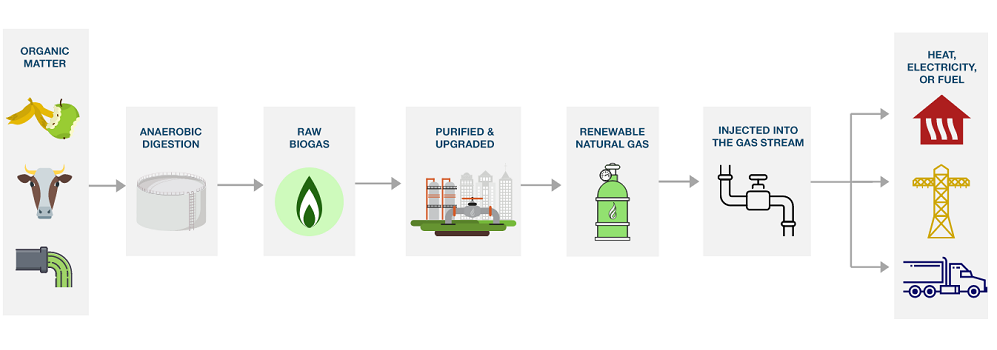Market Snapshot: Producing energy from everyday waste – British Columbia adopts renewable natural gas
Connect/Contact Us
Please send comments, questions, or suggestions for Market Snapshot topics to snapshots@cer-rec.gc.ca
Release date: 2020-09-16
Renewable natural gas (RNG) production typically begins with the collection of organic wastes such as landfill waste, agricultural waste, or waste water. When organic waste decomposes, it releases methane, which is the primary component of natural gas. Producers can capture and purify this methane and inject it as RNG into existing natural gas streams.
Since 2010, an increasing number of utilities and waste management facilities in British Columbia (B.C.) are producing RNG. Fortis BC, a B.C. utility that distributes natural gas, will soon be able to provide roughly 430 000 Gigajoules (GJ), or 0.2%, of total B.C. natural gas end-use demand, with RNG. Fortis customers can opt-in to pay an additional monthly charge to receive a 5 to 100% blend of RNG for residential use. The household cost of RNG blending ranges from $2.35/month for 5% blending, to $47.02/month for 100%.
Figure 1. RNG Production Projects in British Columbia
Source and Description
Source: Fortis B.C.
Description: This map shows the locations of 7 RNG projects currently operating, or in development, in B.C. RNG production is primarily situated near landfill, commercial, agricultural, or other waste-related processing facilities. These sites require an anaerobic digester tank and a biogas upgrader connected to a local distribution pipeline to ensure the safe injection of RNG.
Through its CleanBC initiative, B.C. plans to increase RNG blending to 15% by 2030. This will require a significant increase in production, but according to previous technical estimates, a 15% blending rate is within B.C.’s potential production capacity. One growing source of RNG is from landfill waste, which was responsible for approximately 20% of Canada's total methane emissions in 2017. By diverting waste materials away from landfills, RNG production acts as a carbon-neutral supplement to B.C.’s current natural gas supply.
What is RNG and how is it produced?
There are two ways to produce RNG:
- Organic waste (ex. livestock manure) is processed through anaerobic digestion, where bacteria decompose raw materials into biogas, which is then purified into RNG.
- Methane emissions released from landfill and agricultural waste are captured by perforated pipes and then upgraded into RNG.
Once produced, RNG can be injected into existing gas networks for immediate distribution by utilities. Residential, industrial, and commercial end users can use this fuel without retrofitting their appliances because the methane content in RNG allows the fuel to be used interchangeably with traditional natural gas units.
Figure 2. How is Renewable Natural Gas Produced?

Source and Description
Source: IEA
Description: The infographic demonstrates how decaying organic matter is converted into RNG, which is transformed for heating, electricity, and fueling purposes in B.C. Anaerobic digestion is the most commonly used method for producing bio methane.
- Date modified:
